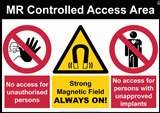MRI (magnetic resonance imaging) is a popular way of creating detailed pictures of organs and other structures inside the body. MRI is commonly used to look at the delicate structures of the heart, brain and spine, and for assessing sports injuries. Unlike other tests, such as X-rays and CT scans, MRI scans do not expose a person to radiation.
As a Cochlear hearing implant recipient, it is important to know about MRI scans, and what to do if you need one.
Where and how do I have an MRI scan?
An MRI scan usually takes place in a hospital and is performed by a radiographer, normally as an outpatient procedure, and can take up to 90 minutes to perform depending on the size of the scan area. You will be positioned on a special table that slides into the tube-shaped scanner. There is a magnetic field around you in the scanner, and the interaction between radio-frequency pulses and field gradients creates a detailed image of the inside of your body.

Can I have an MRI scan with a Cochlear hearing implant?
Your cochlear implant has 2 parts – the internal implant and the external sound processor. These parts are held together by an internal and external magnet. The external sound processor can be removed whenever necessary and sound will stop being transmitted to the implant. The internal implant cannot be removed, and this can have consequences for your MRI scan.
The following points will help you to have a successful MRI scan:
- Talk to your hearing health professional or doctor and find out which type of implant you have – some internal implants can be scanned easily, and others need a bit of preparation.
- You may need to have the Implant Bandage and Splint Kit (MRI Kit) applied around your head before an MRI scan, this reduces the movement of the internal magnet in your implant during the scan. You can ask ahead of time if the MRI centre have a protocol in place or if they require instructions from your clinic.
- You should also check what the strength of the magnetic field is. Typically, hospitals have 1.5 Tesla (T) or 3.0 T MRI scanners.
- If you require an MRI scan of your head or neck, the presence of the internal magnet will cast a shadow on the image regardless of the magnetic field strength and which implant you have. Therefore, MRI scans of the brain normally require temporary magnet removal with a quick surgical procedure.
Is my Cochlear implant MRI-compatible?
Cochlear have had MRI-compatible implants for over 20 years. The Cochlear Nucleus® Series 5 and CI24RE/Freedom® implants are compatible for MRI up to 1.5 T with the internal magnet in place (using the MRI Kit), and up to 3.0 T with the magnet removed1
Cochlear recently launched the Nucleus Profile™ Plus Series Implant so new patients can have a scan in a 1.5 T MRI or 3.0 T MRI without removing the internal magnet* (excluding scans of the brain). This means no additional surgery and no need to use the MRI Kit in the scanner.
What about MRI for Cochlear Baha systems?
For the Baha Connect system, you can have an MRI scan with your external sound processor removed. There will be some shadowing effect caused by the implant and the abutment if the scan is of your head or neck, although the shadow is much smaller than with a cochlear implant.
For the Baha Attract system, scanning is possible at 1.5 T with your external sound processor removed. To undergo a 3.0 T MRI scan, or to reduce the shadowed area, the magnet can be temporarily removed by a medical procedure.
Prior to receiving an MRI, please consult with your doctor about proper precautions.
What else do I need to know?
- You need to be close to an MRI scanner to feel its magnetic effects, so just being in the same hospital or even the same department will not cause you any problems. When you are coming close to an MRI scanner you will see warning signs such as the below to let you know you are entering a controlled area.

- The magnetic field of the MRI scanner can pull metal objects towards it so you would be advised to wear loose clothing with no zips or metallic parts and to remove jewellery, glasses and any coins from your pockets.
- An MRI scan can be very noisy – this is completely normal and is the sound of the scanner taking the images. Even though you are severely or profoundly deaf and may not hear the noise, please wear any earplugs or headphones given to you by the staff. You may still have some functioning structures in your ears that could be damaged by the noise.
- Make sure that the radiographer taking the scan is aware that without your external sound processor, you will not hear anything that they say. Ask them to give you all the instructions before you remove your hearing equipment. If necessary, you can stop the scan at any time by using the button provided to you by the staff.
Cochlear was the first manufacturer to introduce cochlear implants with removable magnets in 1997. Our removable magnet means that even if you were implanted more than 20 years ago you can still access today’s MRI technology, as well as future advances.
Cochlear is always striving to improve our products and the MRI experience of existing implant recipients.
1 Magnetic Imaging Resonance (MRI) Forecast to 2020; MarketsandMarkets; 2016.
*The following implants are designed to be compatible for MRI at 1.5 T and at 3.0 T with the magnet in place: Nucleus Profile Plus: CI612, CI622, CI632.




